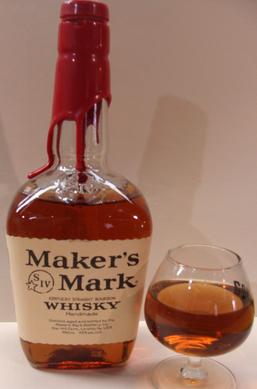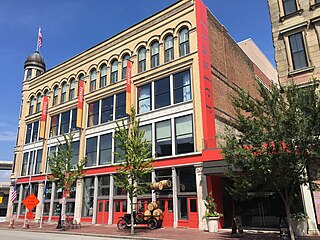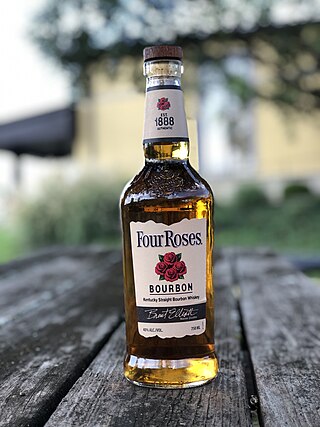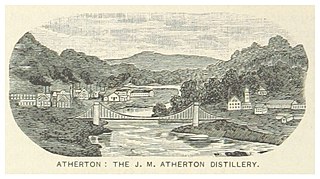
Maker's Mark is a small-batch bourbon whiskey produced in Loretto, Kentucky, by Beam Suntory. It is bottled at 90 U.S. proof and sold in squarish bottles sealed with red wax. The distillery offers tours, and is part of the American Whiskey Trail and the Kentucky Bourbon Trail.

Heaven Hill Distilleries, Inc. is a private, American family-owned and operated distillery founded in 1935 and headquartered in Bardstown, Kentucky, that produces and markets the Heaven Hill brand of Kentucky Straight Bourbon Whiskey and a variety of other distilled spirits.

The Frazier History Museum, previously known as the Frazier Historical Arms Museum and the Frazier International History Museum, is a Kentucky history museum located on Museum Row in the West Main District of downtown Louisville, Kentucky.

Downtown Louisville is the largest central business district in the Commonwealth of Kentucky and the urban hub of the Louisville, Kentucky Metropolitan Area. Its boundaries are the Ohio River to the north, Hancock Street to the east, York and Jacob Streets to the south, and 9th Street to the west. As of 2015, the population of downtown Louisville was 4,700, although this does not include directly surrounding areas such as Old Louisville, Butchertown, NuLu, and Phoenix Hill.

The Galt House Hotel is a 25-story, 1,310-room hotel in Louisville, Kentucky, established in 1972. It is named for two consecutive nearby historic hotels, both named Galt House, erected in 1835 and 1869; the first was destroyed by fire in 1865, and the second, demolished in 1921. The Galt House is the city's only hotel on the Ohio River.

Butchertown is a neighborhood just east of downtown Louisville, Kentucky, United States, bounded by I-65, Main Street, I-71, Beargrass Creek and Mellwood Avenue.

The West Main District is one of the five districts of downtown Louisville, Kentucky. The district, or a portion of it, is listed in the National Register of Historic Places as West Main Street Historic District, due to its containment of some of the oldest structures in the city. The buildings of this district boast the largest collection of cast iron façades of anywhere outside New York's SoHo district. The district also features "Museum Row", a collection of several notable museums located within just a few blocks of each other.

Four Roses is a brand of Kentucky straight bourbon whiskey produced in Lawrenceburg, Kentucky. Its Spanish Mission-style distillery was built in 1910 and is listed on the National Register of Historic Places as Old Prentice Distillery. The company's warehouse for aging and bottling operations is in Cox's Creek, Kentucky. The brand and its products have evolved and transformed since the company's founding in the late 19th century, and especially since the firm's acquisition by the Kirin Brewery Company of Japan at the beginning of the 21st century.

Buffalo Trace Distillery is a distillery in Frankfort, Kentucky, United States, owned by the Sazerac Company. It has historically been known by several names, including the George T. Stagg Distillery and the Old Fashioned Copper (O.F.C.) Distillery. Its namesake bourbon brand, Buffalo Trace Kentucky Straight Bourbon whiskey, was introduced in August 1999. The name "Buffalo Trace" refers to the ancient buffalo trackway that crosses the Kentucky River in Franklin County, Kentucky. The Sazerac Company purchased the distillery in 1992.

The Kentucky Bourbon Trail, sometimes informally referred to as "the Bourbon Trail", is a program sponsored by the Kentucky Distillers' Association (KDA) to promote the Bourbon whiskey industry in Kentucky. The KDA has registered the phrase "Kentucky Bourbon Trail" as a protected trademark.

Old Forester is a brand of Kentucky straight bourbon whisky produced by the Brown–Forman Corporation. It has been on the market continuously for longer than any other bourbon, and was the first bourbon sold exclusively in sealed bottles. It was first bottled and marketed in 1870 by the former pharmaceutical salesman turned bourbon-merchant George Garvin Brown – the founder of the Brown–Forman Corporation. During the Prohibition period from 1920 to 1933, Brown–Forman received one of only six licenses authorizing lawful production.

Joseph & Joseph is an architectural firm founded in 1908 in Louisville, Kentucky. The main services include architectural, engineering and design projects.
Luckett & Farley is an architecture, engineering, and interior design firm based in Louisville, Kentucky. It was founded in 1853, making it the oldest continually operating architecture firm in the United States that is not a wholly owned subsidiary. The firm began under the name Rogers, Whitestone & Co., Architects, changing its name to Henry Whitestone in 1857, to D.X. Murphy & Brother in 1890, and to Luckett & Farley in 1962. The company is 100% employee-owned as of January 1, 2012 and concentrates on automotive, industrial, federal government, higher education, health and wellness, and corporate/commercial markets. There are more LEED professionals at Luckett & Farley than any other company in Kentucky with 50, as of December 2012.

Henry Whitestone (1819–1893) was an architect born in County Clare, Ireland who became one of the main architects of Louisville, Kentucky.
Athertonville is an unincorporated community located in LaRue County, Kentucky, United States. The community was originally named Medcalf when first established in April 1884, but was renamed the following month to Athertonville.

James E. Pepper is an American whiskey brand. The brand is named after a historic American whiskey maker with that name who built and operated a distillery in Lexington, Kentucky, and marketed his whiskey under his family's brand name "Old Pepper" and under his own name. The brand's distillery, known as the Henry Clay distillery and later as the Old Pepper distillery and James E. Pepper distillery, was shut down in 1958 and was left abandoned for more than 50 years until Amir Peay purchased the historic distillery site and relaunched the brand name in 2008. Distilling resumed at the site in 2017.
John McDougal Atherton was an American businessman, property developer, economist, investor and politician based in Louisville, Kentucky. Atherton was elected to one term as a member of the Kentucky House of Representatives from 1869 to 1871, and served as a Democrat. As a third generation distiller, he was best known for Atherton Whiskey, a brand he owned until 1899.

Atherton Whiskey was a pre-prohibition brand of Kentucky Straight Bourbon whiskey first produced by J M Atherton & Co, a chemical and distilling business.




















